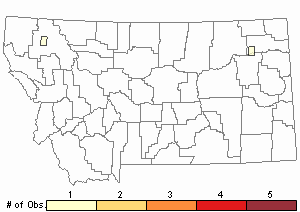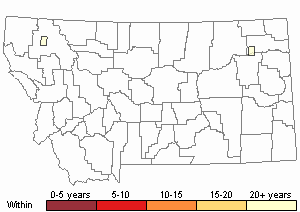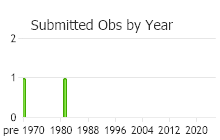View in other NatureServe Network Field Guides
NatureServe
Montana
Utah
Wyoming
Idaho
Wisconsin
British Columbia
South Carolina
Yukon
California
New York
A Lime Moss - Didymodon rigidulus
Other Names:
Barbula rididula
General Description
Plants: Acrocarpous. Growing in upright clumps or cushions (Lawton 1971), green to very dark green. Stems sometimes reaching 20 mm in height; possessing a central strand; hairs of the leaf axil ca 5 cells long, the first 1 or 2 cells brown (FNA 2007).
Leaves: Overlapping, upright and close to the stem to spreading slightly when dry, sometimes spreading more than 45 degrees, 0.8-3 mm in length, grooved transversely or sometimes along the costa, strap-shaped or lance-shaped with ovate tendencies, narrowing to the acute or sometimes subulate leaf tip, the leaf tip sometimes easily broken; margins curved back and downward and centered at mid-leaf for ca 1/2 the leaf length; costa extending to or shortly beyond the leaf tip, typically as a wide and dull-ended subula (FNA 2007).
Leaf Cells: Upper laminal cells isodiametric, smooth or with simple or 2-lobed papillae, the upper margins or apex sometimes almost entirely of 2 cell-layers; proximal laminal cells quadrangular; costa with square ventral cells, in X-section with 1 row of guide cells (FNA 2007), and frequently with ventral and dorsal stereid bands, the ventral band weak (Lawton 1971).
Didymodon rigidulus var. ditrichoides: Leaves upright and strongly flattened to the stem when dry, narrowly lance-shaped; costa extending well beyond the leaf tip; upper lamina 1 cell-layer thick.
Didymodon rigidulus var. gracilis: Present in Montana. Leaves upright and near to the stem or spreading a little when dry; costa typically extending to the leaf tip or shortly beyond it, forming a stiff subula; upper margins sometimes 2 cell-layers thick in places.
Didymodon rigidulus var. icmadophilus: Leaves upright and near to the stem or spreading a little when dry; costa typically extending well beyond the apex, the subula easily broken; upper lamina seldom patchily 2 cell-layers thick.
Didymodon rigidulus var. rigidulus: Leaves upright and near to the stem or spreading a little when dry, spreading when wet, lance-shaped with oblong tendencies or long and deltoid; costa typically extending beyond the stem shortly with a dull end; upper lamina 2 cell-layers thick at the leaf tip or along the edges.
Didymodon rigidulus var. subulatus: Leaves upright and near to the stem or spreading a little when dry, lance-shaped, somewhat uniform in width; costa extending beyond the stem, forming a subula; lamina 2 cell-layers thick from mid-leaf to ca 3/4 up the leaf.
Adapted from FNA 2007.
Phenology
Didymodon rigidulus var. gracilis: Fruit ripens nearly throughout the year.
Didymodon rigidulus var. icmadophilus: Fruit ripens summer through autumn.
Didymodon rigidulus var. rigidulus: Fruit ripens mid-spring through early autumn.
Didymodon rigidulus var. subulatus: Time of fruit ripening unknown.
Adapted from FNA 2007.
Diagnostic Characteristics
Varieties gracilis and icmadophilus resemble each other generally; variety icmadophilus has longer, almost thread-like subulae, and its upper cells are mostly smooth rather than usually papillose as in variety gracilis.
Adapted from FNA 2007.
Range Comments
Didymodon rigidulus: Known in Montana from Fergus, Flathead, Glacier, McCone, Meagher, Roosevelt, and Garfield Counties (Elliott & Pipp, 2016).
North American Range of Varieties
Didymodon rigidulus var. ditrichoides: NT (FNA 2007).
Didymodon rigidulus var. gracilis: AK to NL, NV, MT to AZ and NM, SD, KS, and TX, MN to MO, WI, TN; Mexico (FNA 2007). Known in Montana from Carter, Fallon, Flathead, Garfield, Glacier, Lewis and Clark, McCone, Meagher, Park, Ravalli, and Roosevelt Counties (Elliott & Pipp, 2016).
Didymodon rigidulus var. icmadophilus: AK to NT, BC to AB, also MB, QC and NL, CA and NV, MT and CO, SD and TX, TN and NY; Mexico (FNA 2007). Known in Montana from Flathead County (Elliott & Pipp, 2016).
Didymodon rigidulus var. rigidulus: AK to NT, ON to NL and NS, WY to NM and AZ, ND to TX, IA and MO, WI, MI and IL, NY to VA, FL; Mexico (FNA 2007).
Didymodon rigidulus var. subulatus: Known only from AZ, TX and Mexico (FNA 2007).
Adapted from FNA 2007.
Observations in Montana Natural Heritage Program Database
Number of Observations: 2
(Click on the following maps and charts to see full sized version)
Map Help and Descriptions
Relative Density

Recency


 (Observations spanning multiple months or years are excluded from time charts)
(Observations spanning multiple months or years are excluded from time charts)
Habitat
Didymodon rigidulus var. ditrichoides: Calcareous crags, beyond timberline. Elevation: 3940 feet.
Didymodon rigidulus var. gracilis: Calcareous crags and shelves, soil, areas of small rock fragments basalt, trail edges, tundra. Elevation: 0-9840 feet.
Didymodon rigidulus var. icmadophilus: Calcareous stones, sandstone, soil. Elevation: 130-9190 feet.
Didymodon rigidulus var. rigidulus: Calcareous stones, crags, bluffs, tufa. Elevation: 200-1640 feet.
Didymodon rigidulus var. subulatus: Soil, stones, shelves, gorges. Elevation: 3280-6560 feet.
Adapted from FNA 2007.
Reproductive Characteristics
Dioicous. Perichaetia occurring at the stem apices. Seta sometimes reaching 17 mm in height. Capsule up to 2 mm in length; peristome with 32 teeth or 16 teeth divided to the base, sometimes small or lacking, thread-like to deltoid, sometimes scarcely spiraled.
Specialized vegetative reproduction by several-celled gemmae produced in the leaf axils.
Didymodon rigidulus var. ditrichoides: Peristome unknown; gemmae wanting.
Didymodon rigidulus var. gracilis: Peristome teeth short or longer and spiraled; gemmae frequently produced in axils of upper leaves.
Didymodon rigidulus var. icmadophilus: Peristome teeth short or longer and spiraled; gemmae rare.
Didymodon rigidulus var. rigidulus: Peristome teeth short or longer and spiraled; gemmae frequently produced.
Didymodon rigidulus var. subulatus: Peristome with 16 short or not fully developed teeth.
Adapted from FNA 2007.
Stewardship Responsibility
References
- Literature Cited AboveLegend:
 View Online Publication
View Online Publication Elliott, J.C. and A.K. Pipp. 2018. A Checklist of Montana Mosses (1880-2018). Updated 3 January, 2020. Montana Natural Heritage Program, Helena, Montana. 73 pp.
Elliott, J.C. and A.K. Pipp. 2018. A Checklist of Montana Mosses (1880-2018). Updated 3 January, 2020. Montana Natural Heritage Program, Helena, Montana. 73 pp. Flora of North America Editorial Committee, eds. 2007. Flora of North America North of Mexico. Volume 27. Bryophytes: Mosses, Part 1. Oxford University Press, Inc., NY. xxi + 713 pp.
Flora of North America Editorial Committee, eds. 2007. Flora of North America North of Mexico. Volume 27. Bryophytes: Mosses, Part 1. Oxford University Press, Inc., NY. xxi + 713 pp. Lawton, E. 1971. Moss Flora of the Pacific Northwest. Hattori Botanical Laboratory. Japan: Yamabuki-cho, Shinjuku-ku, Tokyo. 362 pages plus appendices.
Lawton, E. 1971. Moss Flora of the Pacific Northwest. Hattori Botanical Laboratory. Japan: Yamabuki-cho, Shinjuku-ku, Tokyo. 362 pages plus appendices.
- Additional ReferencesLegend:
 View Online Publication
View Online Publication
Do you know of a citation we're missing? Crum, H.A. and L.E. Anderson. 1981. Mosses of Eastern North America. 2 volumes. Columbia University Press, New York. 1328 pp.
Crum, H.A. and L.E. Anderson. 1981. Mosses of Eastern North America. 2 volumes. Columbia University Press, New York. 1328 pp. Elliot, J. C. 1993. Second checklist of Montana mosses. Unpublished report. U.S. Forest Service, Region 1. Missoula, MT. 45 pp.
Elliot, J. C. 1993. Second checklist of Montana mosses. Unpublished report. U.S. Forest Service, Region 1. Missoula, MT. 45 pp. Flowers, S. 1973. Mosses: Utah and the West. Brigham Young University, Provo, Utah. 567 p.
Flowers, S. 1973. Mosses: Utah and the West. Brigham Young University, Provo, Utah. 567 p. Lawton, E. 1971. Keys for the Identification of the Mosses on the Pacific Northwest. Reprinted from 'Moss Flora of the Pacific Northwest'. Published as Supplement No. 2 of the Journal of the Hattori Botanical Laboratory. Nichinan, Miyazaki, Japan. 66 pp.
Lawton, E. 1971. Keys for the Identification of the Mosses on the Pacific Northwest. Reprinted from 'Moss Flora of the Pacific Northwest'. Published as Supplement No. 2 of the Journal of the Hattori Botanical Laboratory. Nichinan, Miyazaki, Japan. 66 pp. Malcolm, B., N. Malcolm, J. Shevock, and D. Norris. 2009. California Mosses. Nelson, New Zealand: Micro-Optics Press. 430 pp.
Malcolm, B., N. Malcolm, J. Shevock, and D. Norris. 2009. California Mosses. Nelson, New Zealand: Micro-Optics Press. 430 pp. Smith, A.J.E. 1980. The Moss Flora of Britain and Ireland. Cambridge University Press, Cambridge. 705 pp.
Smith, A.J.E. 1980. The Moss Flora of Britain and Ireland. Cambridge University Press, Cambridge. 705 pp.
- Web Search Engines for Articles on "A Lime Moss"





